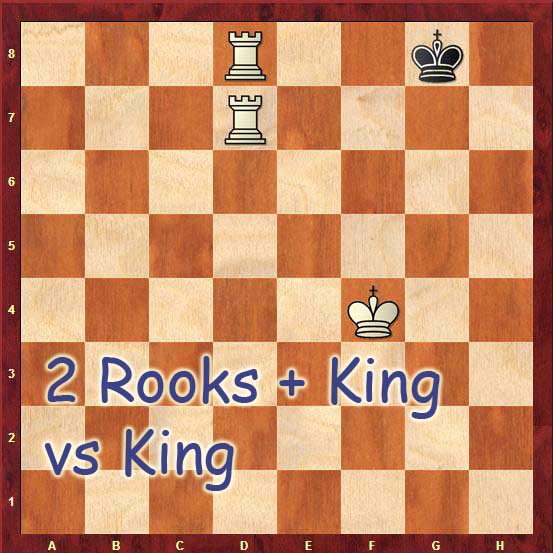Two Rooks and King vs King
In this article, let us discuss the ways in which the opponent King can be checkmated using the King and Two Rooks at your disposal.
The King, as we know, can move only one square either on any of the sides, front, back or on either of the two sides. The rooks, on the other hand, are capable of moving any number unoccupied squares either horizontally or vertically, but they cannot move diagonally.
When you have Two rooks at your disposal, the King need not have a major role to play. The two rooks by themselves can complete the job of capturing the opponent king. However, it has to be ensured that the two rooks should not be in the same file, as they would get in each other’s way. The two rooks should be two different files. The opponent king need not be forced to move to any of the four corners to effect the check mate. It is sufficient that the opponent King is forced to move to the first or the last rank, and either to the “a” file or the “h” file.
To make the point more clear, let us assume the positions in a chessboard as follows: The opponent King is in “c6”; your king is in “d1”, one of your rooks in “h4” and the other rook is in “g5”.
Now the opponent King is restricted from moving into the 5th rank from its existing 6th rank. The king can move in any of the squares in the 6th, 7th or 8th ranks.
If it is your turn to make the move, it would be better if you use the rook in “h4” to attack the king in the 6th rank, than the rook in the 5th rank. While victory is any ensured, moving the rook in the 5th rank will offer a chance for the opponent to come to 5th rank and you need one more or a few moves to corner the king to the flanks or to the 8th rank of the 1st rank.
You can move the rook in “h4” to “h6” and say “check” for the opponent king. Since there is another rook in the 5th rank, the opponent King has no other alternative but to move to the 7th rank.
Having forced the opponent King to the 7th rank, the next move from your end would be the rook in the 5th rank at “g” file and not the rook at the 6th rank at “h” file. Your move of “Rg7” will force the opponent king to move to the 8th rank.
Then the last move from your end will to move the rook in “h” file in 6th rank to the 8th rank and attack the opponent king. The King cannot move in to the 7th rank and as such, he is captured.
Your king will have little or no role when you have two rooks at your disposal.
Here, I would like to share an interesting point with you. In value terms, two rooks combined have a value higher than that of a queen, which has a value of 9. Two rooks joined together give a value of 10, while a combination of a rook and a bishop or a combination of a rook and a knight will give you a value of 8, which is less than the value of the Queen.
Two rooks are more powerful than a Queen is, though they are allowed to move only horizontally and vertically.
Other Interesting Related Posts you should read:




One Comment
[...] How to checkmate using King and Two Rooks vs. King Two Rooks [...]